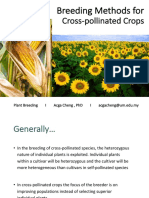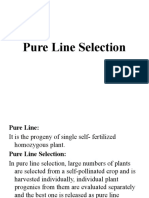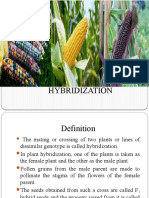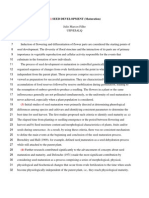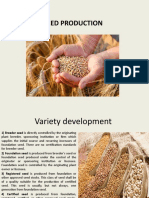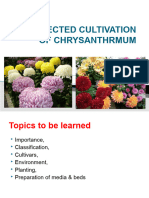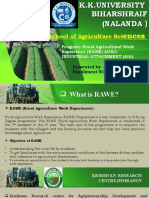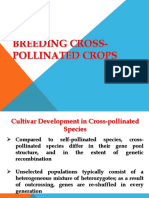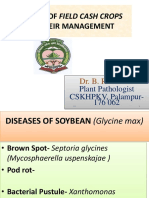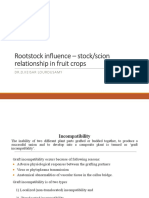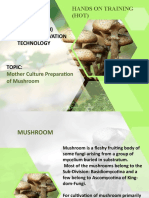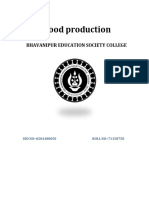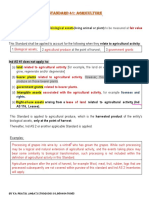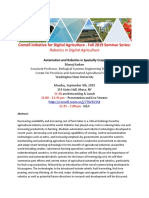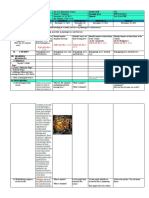Method of Plant Breeding in Cross Pollinated Plants
Method of Plant Breeding in Cross Pollinated Plants
Uploaded by
Adita Nur FaoziyahCopyright:
Available Formats
Method of Plant Breeding in Cross Pollinated Plants
Method of Plant Breeding in Cross Pollinated Plants
Uploaded by
Adita Nur FaoziyahOriginal Description:
Copyright
Available Formats
Share this document
Did you find this document useful?
Is this content inappropriate?
Copyright:
Available Formats
Method of Plant Breeding in Cross Pollinated Plants
Method of Plant Breeding in Cross Pollinated Plants
Uploaded by
Adita Nur FaoziyahCopyright:
Available Formats
Method of Plant Breeding in Cross Pollinated Plants Selection with
Progeny Testing
With Progeny Testing:
In this method initial plants are selected on the basis of their phenotype, but the final
selection of plant based on progeny test. This method includes progeny selection on ear to
row method and recurrent selection.
Progeny Selection (Ear to Row Method):
Hopkins in 1908 developed this method, extensively used in maize. In its simplest form it
consists of
i) 50- 100 number of plants are selected on the basis of their phenotype and are allowed to
open pollinate. The seeds from individual plants are harvested separately.
ii) A single row of 10-50 plants i.e a progeny row, is grown from each selected plant. The
progeny rows are evaluated for desirable character and superior are identified.
iii) Several phenotypically superior plants are selected from the superior progenies and
selected plants are permitted to open pollinate.
iv) Small progeny rows are again grown from the selected plants, and the process of
selection is repeated.
This method is relatively simple and the selection cycle is of one year only. However, it
suffers from the defect that the weak and inferior progenies pollinate plants in the superior
progenies. This reduces the effectiveness of selection.
Merits of Ear to Row Method:
1) In this method the selection is based on the progeny test and not phenotype of individual
plants, hence it is more efficient than mass selection in the identification of superior
genotypes.
2) Inbreeding may be avoided to certain extent by selecting sufficiently large number of
progenies.
3) It is simple and easy.
Demerits Ear to Row Method:
1) There is no control on pollination and plants are allowed to open pollinate, thus selection
is based on maternal parent only. This reduces the efficiency of selection.
2) Many progeny selection schemes are complicated and involve considerable work.
3) The selection cycle is usually of the two years. Thus , time requirement for selection is
twice as that of mass selection.
Plant to Row Method:
Louis De Vilmorin first used it for improvement of Sugarbeet. In this number of plants are
selected and they are open pollinated and the individual plants are harvested separately.
The progeny rows are grown from each selected plant and are evaluated for desirable
character. The superior progenies are identified. Several similar plants are selected from the
progenies and allowed to open pollinate thus selection process is repeated. This method
helps to know the superiority of plants, whether due to environment or genetic variation.
Similarly by growing progenies of 8 to 58 plants, range of genetic variability can be
established. E. g Cotton, Jute, Sunflower and Castor, etc.
http://agriinfo.in/default.aspx%3Fpage%3Dtopic%26superid%3D3%26topicid%3D1771+&cd=6&hl=id&ct
=clnk
You might also like
- Breeding Methods in Self-Pollinated CropsDocument56 pagesBreeding Methods in Self-Pollinated Cropsamy100% (2)
- Olericulture I PM XIDocument160 pagesOlericulture I PM XIYano100% (1)
- Llewellyn's 2010 Witches' Companion - An Almanac For Everyday Living - Desconocido PDFDocument292 pagesLlewellyn's 2010 Witches' Companion - An Almanac For Everyday Living - Desconocido PDFRicardo Lindquist100% (5)
- 11-Breeding Methods of Self-Pollinated Crops Hybridization (Pedigree Selection, Bulk Selection and Single Seed Descent Method) .Document17 pages11-Breeding Methods of Self-Pollinated Crops Hybridization (Pedigree Selection, Bulk Selection and Single Seed Descent Method) .Ali SherNo ratings yet
- W8 LecturesDocument31 pagesW8 LecturesLEE ZIWEINo ratings yet
- Pure Line SelectionDocument17 pagesPure Line SelectionMohaajanan AliNo ratings yet
- Hybrid Seed Production and Breeding Methods in Chilli: Capsicum AnnuumDocument11 pagesHybrid Seed Production and Breeding Methods in Chilli: Capsicum AnnuumShalin Mano100% (1)
- Mass SelectionDocument21 pagesMass SelectionMohaajanan AliNo ratings yet
- Anther or Pollen CultureDocument15 pagesAnther or Pollen Culturej131089No ratings yet
- Chapter 3.seed CertificationDocument9 pagesChapter 3.seed Certificationalemneh bayeh100% (1)
- Plant Breeding Principles and MethodsDocument52 pagesPlant Breeding Principles and MethodsTäð Œvê MîðNo ratings yet
- HYBRIDIZATIONDocument22 pagesHYBRIDIZATIONPoshan Shah ThakuriNo ratings yet
- 6.true Potato Seed - 0Document10 pages6.true Potato Seed - 0Almoustakbel Aloustakbel100% (1)
- Seed Technology 312Document414 pagesSeed Technology 312shiva kumar goud100% (1)
- 3A Seed DevelopmentDocument22 pages3A Seed DevelopmentHitsugaya AbdullahNo ratings yet
- Objective of Seed CertificationDocument4 pagesObjective of Seed Certificationvivekshula.4444100% (1)
- Agronomy of Seed Production and Agroclimatic ZonesDocument46 pagesAgronomy of Seed Production and Agroclimatic ZonesnabiNo ratings yet
- Maintenance of Wheat VarietiesDocument4 pagesMaintenance of Wheat VarietiesMuhammad Boota SarwarNo ratings yet
- SEED Study Materiyal-1Document24 pagesSEED Study Materiyal-1Sridhar Sridhar100% (1)
- Weeds (Afp)Document94 pagesWeeds (Afp)Chrisz Etrata BibayNo ratings yet
- Heterosis Breeding in Vegetable CropsDocument10 pagesHeterosis Breeding in Vegetable CropsVishnu Varthini Bharath50% (2)
- Seeds ProductionDocument17 pagesSeeds ProductionSevar SamiNo ratings yet
- Presentation1 M.SC EntoDocument25 pagesPresentation1 M.SC EntoSree NaveenaNo ratings yet
- Unit 2 Concept of Breeding in CropsDocument3 pagesUnit 2 Concept of Breeding in CropsYASHPAL SINGHNo ratings yet
- Canopy Management SapotaDocument15 pagesCanopy Management SapotaAbhishekp0% (1)
- Seed Production in Self Pollinated Crops - WheatDocument18 pagesSeed Production in Self Pollinated Crops - Wheatalemneh bayehNo ratings yet
- NEW LAB MANUAL - Fundamentals of AgronomyDocument57 pagesNEW LAB MANUAL - Fundamentals of AgronomyURK20AC1100 SEENIVASAN VNo ratings yet
- Orchid CultivationDocument20 pagesOrchid CultivationJeena JohnNo ratings yet
- Floral Biology and Fruit Set OF Mango, Citrus and Grape: M.Vijayalaxmi RHM/08-23 M.SC (Hort) 1 YrDocument52 pagesFloral Biology and Fruit Set OF Mango, Citrus and Grape: M.Vijayalaxmi RHM/08-23 M.SC (Hort) 1 Yrpavani100% (5)
- Hybrid Seed Production of CucurbitsDocument6 pagesHybrid Seed Production of CucurbitsMd. Sajjad HossenNo ratings yet
- Biochemical and Physiological Changes During RipeningDocument25 pagesBiochemical and Physiological Changes During RipeningAGRI KUDUMIYANMALAINo ratings yet
- Agri 122 Crop ImprovementDocument28 pagesAgri 122 Crop ImprovementRazelle Manceras80% (5)
- Cultivation and Uses of CerealsDocument24 pagesCultivation and Uses of Cerealsgaurav yadavNo ratings yet
- Types of Protected Structures and Their Components: NtroductionDocument18 pagesTypes of Protected Structures and Their Components: NtroductionLuís Coelho100% (1)
- Chemical Composition of SeedDocument51 pagesChemical Composition of SeedBramesty Laras HanifNo ratings yet
- Lecture - 15 PDFDocument5 pagesLecture - 15 PDFIndu LekhaNo ratings yet
- Chemistry of SeedDocument9 pagesChemistry of SeedDien NovitaNo ratings yet
- Propagation and Nursery ManagementDocument22 pagesPropagation and Nursery ManagementVutchili Utchili100% (2)
- Protected Cultivation of ChrysanthemumDocument51 pagesProtected Cultivation of ChrysanthemumhiteshridalaiNo ratings yet
- Laboratory 1 Seed MorphologicalDocument17 pagesLaboratory 1 Seed MorphologicalJohn Rey De Los SantosNo ratings yet
- Floral Structure, Breeding and Pollination Mechanism During Seed Production in BarleyDocument23 pagesFloral Structure, Breeding and Pollination Mechanism During Seed Production in BarleyJai Prakash Gupta100% (1)
- Practical Exam 2019Document1 pagePractical Exam 2019Vikki NandeshwarNo ratings yet
- NishaDocument23 pagesNishaBhumihar BoyNo ratings yet
- Crop Production Technology - Kharif CropsDocument32 pagesCrop Production Technology - Kharif CropsAKSHAY THOTTUVANo ratings yet
- Pest and Diseases of CacaoDocument39 pagesPest and Diseases of CacaoVimarce CuliNo ratings yet
- Chapter 9 Breeding Cross-Pollinated and Clonally Propagated CropsDocument19 pagesChapter 9 Breeding Cross-Pollinated and Clonally Propagated CropsXwag 12No ratings yet
- Chemical Hybridizing Agents-Report2Document47 pagesChemical Hybridizing Agents-Report2Wahid BuxNo ratings yet
- Plpath233 IV Diseases of Field Crops and Their ManagementDocument75 pagesPlpath233 IV Diseases of Field Crops and Their ManagementManjeet DhNo ratings yet
- Seed Prodtn of Veg CropsDocument63 pagesSeed Prodtn of Veg CropsDR V S PATILNo ratings yet
- Digestive System of GrasshopperDocument8 pagesDigestive System of GrasshopperAshish SharMa100% (1)
- Lecture 11 HOR 111 Stock Scion RelationshipDocument27 pagesLecture 11 HOR 111 Stock Scion RelationshipRahul SajitNo ratings yet
- ORGAN CULTURE, Anther & Pollen CultureDocument72 pagesORGAN CULTURE, Anther & Pollen CultureSanthiyaNo ratings yet
- 05-Postharvest Handling of AvocadoDocument14 pages05-Postharvest Handling of AvocadolangtuduongsonttNo ratings yet
- Seed Prodtn of Veg CropsDocument63 pagesSeed Prodtn of Veg CropsDR V S PATILNo ratings yet
- Insect Pests of Brinjal-By Nanadana Nayana KumaraDocument45 pagesInsect Pests of Brinjal-By Nanadana Nayana KumaraNandana Nayana KumaraNo ratings yet
- Chapter 1 FinalDocument50 pagesChapter 1 FinalJr AquinoNo ratings yet
- Mushroom Production 1Document9 pagesMushroom Production 1Shinni Jashvie JalipaNo ratings yet
- Mother Culture PreparationDocument27 pagesMother Culture PreparationMonica R GNo ratings yet
- Pests of Field Crops and Pastures: Identification and ControlFrom EverandPests of Field Crops and Pastures: Identification and ControlPT BaileyNo ratings yet
- Food Production Hand WrittenDocument18 pagesFood Production Hand WrittenAnand JhaNo ratings yet
- IBPS AFO Syllabus 2Document3 pagesIBPS AFO Syllabus 2deepak palNo ratings yet
- Upgrade and Evolution in Food IndustryDocument31 pagesUpgrade and Evolution in Food IndustryAll DocumentsNo ratings yet
- Hydroponic Farming in Indian HotelsDocument4 pagesHydroponic Farming in Indian HotelsInternational Journal of Innovative Science and Research TechnologyNo ratings yet
- Caracteristici Portaltoi MarDocument14 pagesCaracteristici Portaltoi Marmarius1979No ratings yet
- Ambo UniversityDocument52 pagesAmbo UniversityIbrahim MohammedNo ratings yet
- Reading Comprehension Fruits Part 2 Copyright Teacher Created Resources PDFDocument7 pagesReading Comprehension Fruits Part 2 Copyright Teacher Created Resources PDF14 Kursant(in)No ratings yet
- Thinking Skills Assessment (Tsa) Test SpecificationDocument23 pagesThinking Skills Assessment (Tsa) Test Specificationlyly100% (1)
- Unit 5 Rgqs and Vocab f18Document2 pagesUnit 5 Rgqs and Vocab f18api-327777794No ratings yet
- Attachment Summary Sheet - Agriculture ExtensionsDocument13 pagesAttachment Summary Sheet - Agriculture ExtensionsAasheeshh Kushhwaha100% (1)
- Pointers in Format Preparation For Thesis Outline/ManuscriptDocument44 pagesPointers in Format Preparation For Thesis Outline/ManuscriptHector C. GAYOMBANo ratings yet
- A Textbook of Veterinary Anatomy 1910Document46 pagesA Textbook of Veterinary Anatomy 1910Mohammed AdilNo ratings yet
- Culinary Terms of Vegetables: DictionaryDocument8 pagesCulinary Terms of Vegetables: DictionaryJ MNo ratings yet
- Ind As 41Document9 pagesInd As 41Savin AdhikaryNo ratings yet
- Module 3Document84 pagesModule 3Danica HerealwaysNo ratings yet
- Tropical Plants ListDocument7 pagesTropical Plants ListArgoNavis50% (2)
- A Chinese Biogas ManualDocument135 pagesA Chinese Biogas ManualDaniel Judy100% (1)
- Effect of Organic Fertilizer On The Growth of Tea (Camellia Sinensis L)Document10 pagesEffect of Organic Fertilizer On The Growth of Tea (Camellia Sinensis L)Muhammad Maulana SidikNo ratings yet
- Priority Investment Plan: Cy 2010-2015: Barangay Dao-Angan-Boliney, Abra Province of AbraDocument5 pagesPriority Investment Plan: Cy 2010-2015: Barangay Dao-Angan-Boliney, Abra Province of AbraErnest AtonNo ratings yet
- 10 DTP - 2022-2024 (CapDev Included)Document175 pages10 DTP - 2022-2024 (CapDev Included)City Health Office City of Naga CebuNo ratings yet
- Republic Act No. 10611: GOVPH (/)Document26 pagesRepublic Act No. 10611: GOVPH (/)Christian FarofaldaneNo ratings yet
- Mughal GardensDocument46 pagesMughal GardensparvinmalickNo ratings yet
- Sonalika Tractor ProjectDocument42 pagesSonalika Tractor Projectanmol86% (7)
- 2019.09.DA Seminar Karkee - ManojDocument2 pages2019.09.DA Seminar Karkee - ManojAnonymous b5JQGsmNo ratings yet
- TLE 6 AG-Ob-2-1.2.1 TLE 6 AG-Ob-2 - 1.2.2 TLE 6 AG-Ob-2 - 1.2.3 TLE 6 AG-Ob-2 - 1.2.4 TLE 6 AG-Ob-2 - 1.2.4Document6 pagesTLE 6 AG-Ob-2-1.2.1 TLE 6 AG-Ob-2 - 1.2.2 TLE 6 AG-Ob-2 - 1.2.3 TLE 6 AG-Ob-2 - 1.2.4 TLE 6 AG-Ob-2 - 1.2.4Paul MonrealNo ratings yet
- Vegetable Garden Planting Guide: Use This Guide To Find Out When, Where, and What Vegetables To Plant in Your GardenDocument1 pageVegetable Garden Planting Guide: Use This Guide To Find Out When, Where, and What Vegetables To Plant in Your GardenEmilia VargasNo ratings yet
- TrichodermaDocument3 pagesTrichodermaAzwir AnharNo ratings yet
- Rabi CropsDocument109 pagesRabi CropsGarima Chawla WaliaNo ratings yet
- St. Joseph's SR - Sec. Co Ed School Social Science (GEOGRAPHY) Class IXDocument17 pagesSt. Joseph's SR - Sec. Co Ed School Social Science (GEOGRAPHY) Class IXom guptaNo ratings yet




